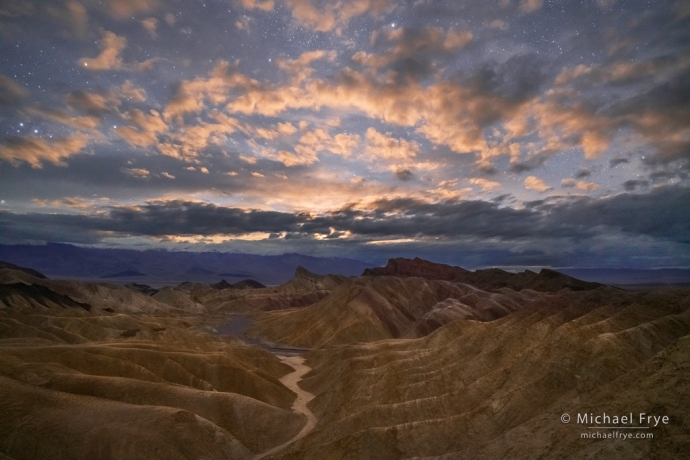The night after the rainstorm cleared during our recent visit to Death Valley, the half-full moon was due to set around midnight, and I thought there might be an opportunity to photograph an interesting moonset if the clouds lingered.
Claudia and I ate dinner at our campsite, slept for about an hour, then I got up and checked the weather. Things looked promising, with clouds, but not too many. So we headed to a spot looking over the badlands toward the lowering moon.
Photographing a moonrise or moonset at night is a lot like photographing a sunrise or sunset. The quality of the light is almost identical, though the light is much dimmer, and you might see stars in the sky. (The dimmer the moonlight, the more stars you’re likely to see.) A nighttime moonrise or moonset can be just as colorful as a sunrise or sunset, though we usually can’t see that color with our eyes, because the color-capturing cones in our retinas don’t function in such dim light. But cameras can easily capture that color.
In this case I was looking toward the setting moon, so the contrast was high, just as if I was looking toward the setting sun. So I did what I would normally do during the day, and bracketed exposures, with the intention of blending them together later to get detail in both highlights and shadows. I think this is even more important at night, when you’re typically using higher ISO values, which lowers the camera’s dynamic range, and amplifies noise when you try to lighten shadows.
In this case I blended two exposures by hand in Photoshop – one shorter exposure for the sky (short in order to prevent the clouds and stars from moving too much) at 15 seconds, f/1.8, ISO 3200, and another longer exposure for the foreground at two minutes, f/1.8, ISO 3200. How did I come up with those settings? Partly by experience, but mostly by evaluating the histogram and blinkies – just as I would during the day.
While I could choose the location, timing, composition, and camera settings, I couldn’t control the clouds. But sometimes luck, or serendipity, works for you, and on this night, at one moment, the clouds formed a beautiful arc over the badlands. I just needed to adjust my composition to fit that arc into the frame in a balanced way.
By the time we got back to camp and back to sleep it was after 1:00 a.m., and we woke up again at 5:00 a.m. for sunrise. But it always seems worth the loss of sleep when you get to experience a beautiful, peaceful, nighttime event like a setting moon.
— Michael Frye
Related Posts: Escaping the Snow; Death Valley after Dark
Michael Frye is a professional photographer specializing in landscapes and nature. He is the author or principal photographer of The Photographer’s Guide to Yosemite, Yosemite Meditations, Yosemite Meditations for Women, Yosemite Meditations for Adventurers, and Digital Landscape Photography: In the Footsteps of Ansel Adams and the Great Masters. He has also written three eBooks: Light & Land: Landscapes in the Digital Darkroom, Exposure for Outdoor Photography, and Landscapes in Lightroom: The Essential Step-by-Step Guide. Michael has written numerous magazine articles on the art and technique of photography, and his images have been published in over thirty countries around the world. Michael has lived either in or near Yosemite National Park since 1983, currently residing just outside the park in Mariposa, California.










I completely agree! Beautiful capture.
Thanks so much Kathy!
This is beautiful. I love these badlands. Thanks for sharing how you made this image, Michael!
I was up at 4am to photograph a moonrise, and it was a stunning sight! The light was so dim and the stars were so clear. I would definitely do it again!
Glad you got to experience that Kathy!